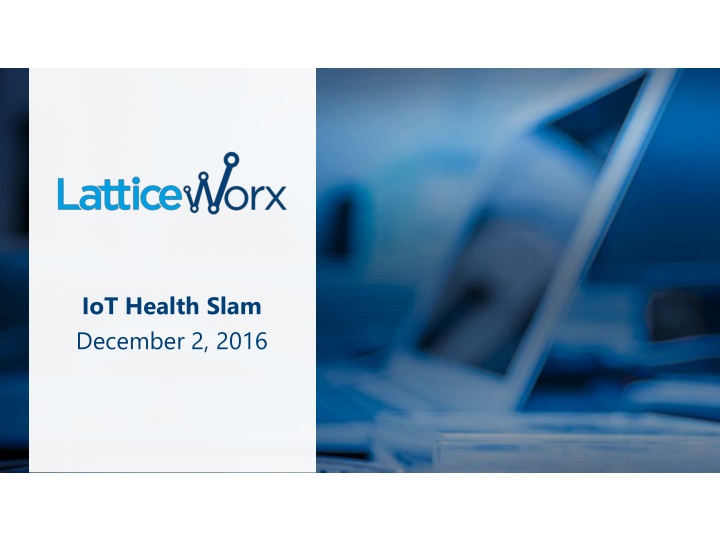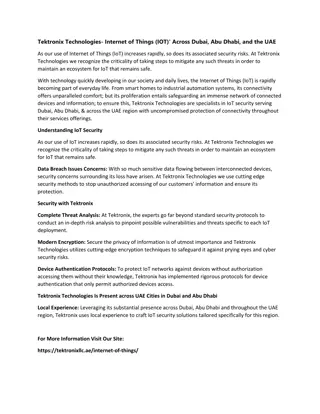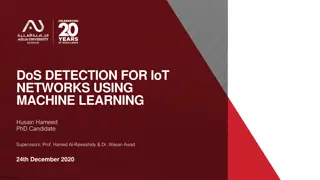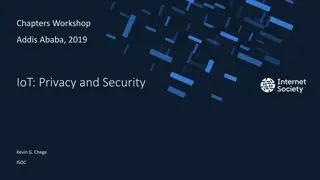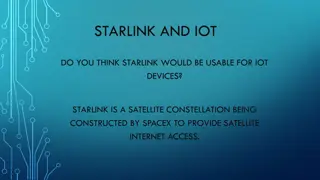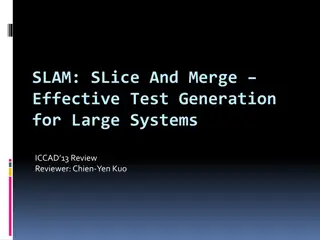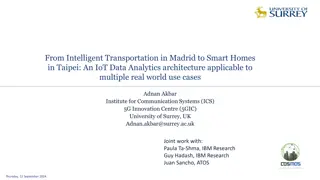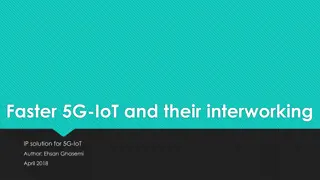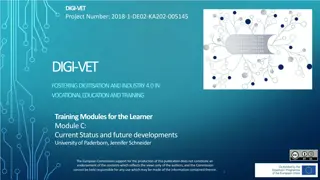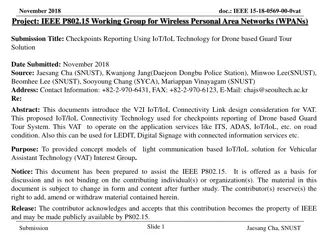IoT Health Slam
"IoT presents vast opportunities in healthcare, with promises of massive scaling and data growth. However, challenges like disconnected data and interoperability issues persist. It is crucial to prioritize understanding clinical pathways and leveraging technology effectively to drive positive change. Addressing issues of data utilization and system interoperability are key in advancing healthcare services."
Download Presentation

Please find below an Image/Link to download the presentation.
The content on the website is provided AS IS for your information and personal use only. It may not be sold, licensed, or shared on other websites without obtaining consent from the author.If you encounter any issues during the download, it is possible that the publisher has removed the file from their server.
You are allowed to download the files provided on this website for personal or commercial use, subject to the condition that they are used lawfully. All files are the property of their respective owners.
The content on the website is provided AS IS for your information and personal use only. It may not be sold, licensed, or shared on other websites without obtaining consent from the author.
E N D
Presentation Transcript
IoT Health Slam December 2, 2016
AGENDA IoT opportunities and challenges in healthcare. A simple problem. A simple solution. What does our future hold?
MASSIVE SCALE IoT promises a massive scaling from existing systems 20B CONNECTED DEVICES BY 2020* $3T MARKET SIZE* Volume of data will dwarf those numbers Velocity of data will grow exponentially * Gartner, http://www.gartner.com/newsroom/id/3165317
DISCONNECTED DATA Health care providers face an onslaught of clinical and non-clinical data Disconnect between increasing amounts of data and how providers do their jobs Data should work for us, not vice versa Enable providers to become more efficient, more proactive and change how care is delivered Don't ask overworked providers to comb through yet another set of meaningful data points
INTEROPERABILITY ISSUES We already have a big challenge making a small number of existing systems interoperable Not a trivial task to get two different EHRs to communicate with each other Providers have a very low positive experience w/interoperability KLAS study: http://www.klasresearch.com/about-us/press- room/2016/10/11/do-clinicians-have-the-interoperability-they-need CIOs say interoperability not even close http://www.politico.com/tipsheets/morning- ehealth/2016/09/interoperability-the-cherished-dream-insurers-start- buying-health-it-services-california-pumps-up-its-pdmp-216559 Common standards emerging, but it s still early days CommonWell Carequality
FIRST THINGS FIRST Understand clinical pathways, then revise as appropriate using technology as a tool Follow Hippocratic Oath reject harm https://en.wikipedia.org/wiki/Hippocratic_Oath Are you actually helping, or just complicating? What good is having actionable data if I don t have any way or anyone to act on it? (FQHC Chief Medical Officer) Data like any technical resource should be part of an entire technology ecosystem Organizations must understand and be realistic about their capacity for change and consider adopting best practices such as ITIL as part of their project
A SIMPLE PROBLEM The cost of a PCP referring one patient to a specialist is a huge source of waste How hard can it be? Well Different providers have different EHRs Organizations have different ways of generating referral forms Different organizations require different data on their referral forms Different payers have different opinions about where the referred patient should go a hospital or a clinic What happens when a simple referral process breaks down?
WHY IT MATTERS Incomplete referrals waste time, cost providers money and frustrate patients If a provider refers a patient to a specialist but that referral gets sent back, the provider is charged a fee Reasons referrals returned: x x x x Incorrect format used for receiving organization Missing or incorrect clinical data Missing or incorrect demographic data Referral not clinically necessary
A SIMPLE SOLUTION We tracked a group of providers who were asked to follow standardized, localized care pathways Care pathways were developed and approved by local providers We measured the cost of referrals for one UK payer group from 2014/15 to 2015/16 In that time a coordinated effort toward managing referrals achieved significant savings: Total patient population increased by 10,000 people Total cost of referrals decreased by over $3.3M Total number of referrals decreased by 13,667 2.7% 13.7% 13.7%
WHY DID IT WORK? Physicians were given ownership of and were held accountable for their clinical decisions Physicians were still in charge of care Physicians had better access to more accurate and timely information at the point of care Physicians had better access to data and put more trust in those data Physicians were able to provide better care at the point of care Technology enabled clinicians to focus on their jobs and not the minutiae of administrative details
SEEING THE FUTURE Healthcare is becoming more proactive Data are coming from: Fitness trackers Wireless scales Devices recording vitals and other diagnostics Can increased, more accurate and more actionable data lead to automated referrals?
SEEING THE FUTURE Instead of relying on a provider, rely on amalgam of data to determine the course of action How can we plan for that? Different mindset Different competencies New technologies Requirements: Organizational readiness Actionable information Proactive impact on behavior
TAKEAWAYS Understand what you are trying to do with all of those data and why you need to collect each and every data point Then build a solution that can take advantage of technology Build in interoperability from the beginning, not as an afterthought. Just like security!
Contact us to learn more Shane Greyvenstein shane@latticeworx.com Ben Kleinman ben@latticeworx.com Connecting Software Systems Improving Healthcare
